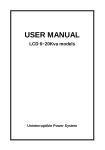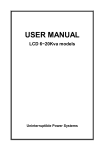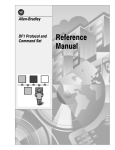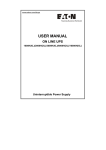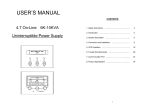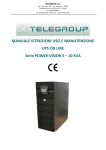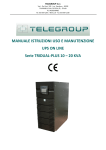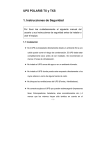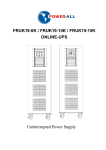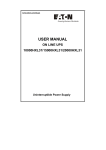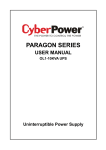Download Siel Green Point 6:20KVA User manual
Transcript
USER MANUAL
0$18$/('·862e INSTALLAZIONE
UPS / Gruppi statici di continuità
Models Green Point 6÷20KVA
Uninterruptible Power System
IV319 Rev.00
Data 2010-06-22
Pag. 1 di 118
CONTENTS
1. Safety and EMC instructions ··························································· 6
1.1 INSTALLATION ············································································ 6
1.2 OPERATION ················································································ 7
1.3 MAINTENANCE, SERVICING AND FAULTS ···································· 8
1.4 TRANSPORT ················································································ 9
1.5 STORAGE···················································································· 9
1.6 STANDARDS ··············································································· 9
2.1 Description of commonly used symbols···································· 10
2.2 Description of commonly used name for phase ······················· 11
3. Introduction ····················································································· 12
3.1 SYSTEM AND MODEL DESCRIPTION ··········································· 12
3.2 PRODUCT SPECIFICATION AND PERFORMANCE ························· 13
4. Display Panel ··················································································· 16
5. Installation························································································ 20
5.1 UNPACKING AND INSPECTION··················································· 20
5.2 INPUT AND OUTPUT POWER CORDS AND PROTECTIVE EARTH
GROUND INSTALLATION ·································································· 20
5.3 OPERATING PROCEDURE FOR CONNECTING THE LONG BACKUP
TIME MODEL UPS WITH THE EXTERNAL BATTERY ·························· 25
5.4 PARALLEL OPERATION ······························································ 26
6. Operation ························································································· 32
6.1 OPERATION MODE ··································································· 32
6.2 PARALLEL OPERATION ····························································· 34
6.3 BACKUP TIME FOR THE STANDARD MODEL ······························· 39
7. Battery Maintenance ······································································· 40
8. Notes for Battery Disposal and Battery Replacement ················ 41
9. Trouble Shooting ············································································· 42
IV319 Rev.00
Data 2010-06-22
Pag. 2 di 118
10. Operating mode for all models ···················································· 44
10.1 NO OUTPUT MODE ································································· 45
10.2 BYPASS MODE ········································································ 45
10.3 LINE MODE ············································································· 46
10.4 BATTERY MODE / BATTERY TEST MODE ·································· 47
10.5 PARALLEL MODE ···································································· 48
10.6 WARNING MODE ····································································· 48
10.7 FAULT MODE ·········································································· 49
10.8 EPO MODE ············································································· 51
11. Setting by LCD Module ································································· 52
12. Communication Port ····································································· 56
12.1 RS232 INTERFACE ································································· 56
12.2 INTELLIGENT SLOT ································································· 56
12.3 AS400 INTERFACE (OPTION) ·················································· 56
13. Software for all models································································· 58
Appendix 1: The Corresponding Form of the LCD Display ············ 59
Appendix 2: Rear Panel ······································································ 60
1. Istruzioni relative alla sicurezza e alla EMC ································· 63
1.1 INSTALLAZIONE········································································ 63
1.2 UTILIZZO·················································································· 64
1.3 MANUTENZIONE, RIPARAZIONE E GUASTI ································· 64
1.4 TRASPORTO ·············································································· 65
1.5 STOCCAGGIO ············································································ 66
1.6 STANDARD ··············································································· 66
'HVFUL]LRQHGHLVLPEROLG¶XVRFRPXQH ······································ 67
2.2 Descrizione dei nomi delle 3 fasi usati nel manuale ················· 68
3. Introduzione ····················································································· 69
3.1 DESCRIZIONE DEL SISTEMA E DEL MODELLO ···························· 69
IV319 Rev.00
Data 2010-06-22
Pag. 3 di 118
3.2 SPECIFICHE E PRESTAZIONI DEL PRODOTTO ······························ 70
4. Descrizione del pannello del display ············································ 73
5. Installazione ····················································································· 77
5.1 DISIMBALLAGGIO E ISPEZIONE ················································· 77
5.2 INSTALLAZIONE DEI CAVI DI ALIMENTAZIONE IN ENTRATA E IN
USCITA E MESSA A TERRA DI PROTEZIONE ······································· 77
5.3 PROCEDURA OPERATIVA PER COLLEGARE GLI UPS ALLA
BATTERIA ESTERNA OVE PREVISTA. ················································ 82
5.4 FUNZIONAMENTO IN PARALLELO·············································· 83
6. Funzionamento ················································································ 89
6.1 MODALITÀ OPERATIVA ····························································· 89
6.2 FUNZIONAMENTO IN PARALLELO·············································· 91
6.3 IL TEMPO DI AUTONOMIA PER IL MODELLO STANDARD·············· 96
7. Manutenzione della batteria ··························································· 97
8. Note per lo smaltimento e la sostituzione delle batterie ············ 98
9. Risoluzione dei problemi································································ 99
10. Modalità operative per tutti i modelli ········································ 102
10.1 MODALITÀ NO OUTPUT ······················································· 103
10.2 MODALITÀ BY-PASS ····························································· 103
10.3 MODALITÀ NORMALE ·························································· 104
10.4 MODALITÀ BATTERIA / MODALITÀ TEST BATTERIA ·············· 105
10.5 MODALITÀ IN PARALLELO ···················································· 106
10.6 MODALITÀ ALLARME ··························································· 106
10.7 MODALITÀ ERRORE ······························································ 107
10.8 MODALITÀ EPO (EMERGENCY POWER OFF) ······················· 108
11. Impostazioni tramite modulo LCD ············································· 109
12. Porte di comunicazione ······························································ 113
12.1 INTERFACCIA RS232 ···························································· 113
IV319 Rev.00
Data 2010-06-22
Pag. 4 di 118
12.2 INTELLIGENT SLOT ······························································· 113
12.3 INTERFACCIA AS400 (OPZIONALE) ······································ 114
13. Software per tutti i modelli ························································· 115
Appendice 1: Legenda del display LCD ········································· 116
Appendice 2: Pannello posteriore ··················································· 117
IV319 Rev.00
Data 2010-06-22
Pag. 5 di 118
1. Safety and EMC instructions
Please read carefully the following user manual and the
safety instructions before installing the unit or using the unit!
1.1 Installation
ღ Condensation may occur if the UPS is moved directly from a cold to
a warm environment. The UPS must be absolutely dry before
being installed. Please allow an acclimatization time of at least two
hours.
ღ Do not install the UPS near water or in damp environment.
ღ Do not install the UPS where it would be exposed to direct sunlight
or near heat.
ღ 'RQRWEORFNYHQWLODWLRQRSHQLQJVLQWKH836¶VKRXVLQJ
ღ Place cables in such a way that no one can step on or trip over
them.
ღ UPS has provided earthed terminal, in the final installed system
configuration, equipotential earth bonding to the external UPS
battery cabinets.
ღ An integral single emergency switching device which prevents
IV319 Rev.00
Data 2010-06-22
Pag. 6 di 118
further supply to the load by the UPS in any mode of operation
should be provided in the building wiring installation.
ღ An appropriate disconnect device as short-circuit backup protection
should be provided in the building wiring installation.
ღ For three-phase equipment connection to an IT power system, a
four-pole device which disconnect all phase conductors and the
neutral conductor should be provided in the building wiring
installation.
ღ This is permanently connected equipment , it must be installed by
qualified maintenance personnel.
ღ Earth connection essential before connecting to the building wiring
terminal.
1.2 Operation
ღ Do not disconnect the earth conductor cable on the UPS or the
building wiring terminals in any time since this would cancel the
protective earthing of the UPS system and of all connected loads.
ღ The UPS output terminal block may be electrically lived even if the
UPS system is not connected to the building wiring terminal.
ღ In order to fully disconnect the UPS, first press the OFF button,
then disconnect the mains lead.
ღ Ensure that no liquid or other foreign objects can enter the UPS.
ღ The UPS can be operated by any individuals with no previous
experience.
IV319 Rev.00
Data 2010-06-22
Pag. 7 di 118
1.3 Maintenance, servicing and faults
ღ
The UPS operates with hazardous voltages. Only qualified
maintenance personnel may carry out repairs.
ღ Caution - risk of electric shock. Even after the unit is disconnected
from the mains power supply (building wiring terminal),
components inside the UPS are still connected to the battery,
which are potentially dangerous.
ღ Before carrying out any kind of service and/or maintenance, please
disconnect the batteries. Verify that no current is present and no
hazardous voltage exists in the capacitor or BUS capacitor
terminals.
ღ Batteries must be replaced only by qualified personnel.
ღ Caution - risk of electric shock. The battery circuit is not isolated
from the input voltage. Hazardous voltages may occur between the
battery terminals and the ground. Verify that no voltage is present
before servicing!
ღ Batteries have a high short-circuit current and pose a risk of shock.
Take all precautionary measures specified below and any other
measures necessary when working with batteries:
᧩ remove all jewellery,
objects.
wristwatches,
rings and other metal
᧩ use only tools with insulated grips and handles.
ღ When changing batteries, replace with the same quantity and the
same type of batteries.
ღ Do not attempt to dispose of batteries by burning them. It could
cause explosion.
ღ Do not open or destroy batteries. Effluent electrolyte can cause
injury to the skin and eyes. It may be toxic.
ღ Please replace the fuse only by a fuse of the same type and of the
IV319 Rev.00
Data 2010-06-22
Pag. 8 di 118
same amperage in order to avoid fire hazards.
ღ Do not dismantle the UPS, except the qualified maintenance
personnel.
1.4 Transport
ღ Please transport the UPS only in the original packaging (to protect
against shock and impact).
1.5 Storage
ღ The UPS must be stockpiled in the room where it is ventilated and
dry.
1.6 Standards
* Safety
IEC/EN 62040-1-1
* EMI
Conducted Emission...........................:IEC/EN 62040-2
Category C3
Radiated Emission..............................:IEC/EN 62040-2
Category C3
*EMS
ESD.....................................................:IEC/EN 61000-4-2
Level 4
RS........................................................:IEC/EN 61000-4-3
Level 3
EFT...................................................... :IEC/EN 61000-4-4
Level 4
SURGE............................................... :IEC/EN 61000-4-5
Level 4
CS....................................................... :IEC/EN 61000-4-6
Level 3
Power-frequency Magnetic field.......... :IEC/EN 61000-4-8
Level 3
Low Frequency Signals........................:IEC/EN 61000-2-2
IV319 Rev.00
Data 2010-06-22
Pag. 9 di 118
Warning: This is a product for commercial and industrial application in the
second environment-installation restrictions or additional measures may be
needed to prevent disturbances.
2.1 Description of commonly used symbols
Some or all of the following symbols may be used in this manual. It is
advisable to familiarize yourself with them and understand their
meaning:
This indicate how
It indicate step by step
open the package
how install the UPS
Read & understood
the manual before
operate on UPS
IV319 Rev.00
Data 2010-06-22
Pag. 10 di 118
2.2 Description of commonly used name for phase
In the UPS with 3phases input, the 3 phases are called:
³$³³%´³&³
,QWKLVPDQXDOWKHSKDVHVDUHQRUPDOO\FDOOHG ³$³³%´³&³
RUVRPHWLPHDUHFDOOHG³5´³6´³7³
´3KDVH A´LVsame as ³SKDVHR ³or ³3KDVHL1 ³
´3KDVHB´LVVDPHDV³SKDVHS ³RU³3KDVHL2 ³
´3KDVH C´LVVDPHDV³SKDVHT ³RU³3KDVHL3 ³
IV319 Rev.00
Data 2010-06-22
Pag. 11 di 118
3. Introduction
3.1 System and model description
This Green Point Series is an uninterruptible power supply
incorporating double-conversion technology. It provides perfect
protection specifically for computer equipment, communication
systems to computerized instruments.
Its true online double-conversion design eliminates all mains power
disturbances. A rectifier converts the alternating current from the
utility power to direct current. This direct current charges the
batteries and powers the inverter. On the basis of this DC voltage,
the inverter generates a pure sinusoidal AC voltage, which is
constantly powering the loads.
Computers and Peripherals are thus powered entirely by the UPS.
In the event of power failure, the maintenance-free batteries power
the inverter.
This manual is applicable to the following models:
Model No.
Type
Green point 6kVA 1/1
Green point 10kVA 1/1
Internal Battery
Green point 10kVA 3/1
Green point 10kVA 1/1
Green point 10kVA 3/1
External Battery
Green point 15kVA 3/1
Green point 20kVA 3/1
³6´0RGHO/RQJEDFNXSWLPH
IV319 Rev.00
Data 2010-06-22
Pag. 12 di 118
3.2 Product Specification and Performance
1) General Specification
Model
Power Rating
6K 1/1
10K 1/1 (S)
10K 3/1 (S)
15K 3/1
20K 3/1
6KVA
10KVA
10KVA
15KVA
20KVA
4,2KW
7KW
7KW
10,5KW
14KW
50/60
50/60
50/60
50/60
50/60
Frequency (Hz)
Voltage (176-276)VAC (176-276)VAC
(304-478)VAC
(304-478)VAC (304-478)VAC
Input
Current
32A max.
50A max
50A max
75A max
100A max
Voltage
240VDC
240VDC
240VDC
240VDC
240VDC
Current
24A max
40A max
40A max
60A max
80A max
43/45/43/42A
65/68/65/63A
87/91/87/83A
260x570x717
260x570x717 260x570x717
Battery
Voltage
208/220/230/240VAC
Output
Current 26/27/26/25A 43/45/43/42A
Dimension
(WxDxH) mm
260x570x717 260x570x717
Weight (kg)
90
93 (38)
94 (39)
55
55
Note: on 10K (S) are the version without internal battery
2) Electrical Performance
Input
Model
Voltage
Frequency
Power Factor
1/1 6K / 10K
Single-phase 46-54Hz/56-64Hz
>0.98 (Full load)
3/1 10K / 15K / 20K
Three-phase
46-54Hz/56-64Hz
+N
>0.95 (Full load)
Output
Voltage
Regulation
1%
Power
Factor
Frequency
tolerance.
0.7 lag
Synchronized
46-54Hz/ 56-64Hz in
Line mode (AC
mode)
0.1% of normal
frequency in Battery
mode
IV319 Rev.00
Data 2010-06-22
Distortion
THD<2%
Full load
(Linear
Load)
Overload capacity
Current
crest ratio
105%-130% load transfers to
Bypass mode after 10 minutes
3:1
>130% load transfers to Bypass
maximum
mode after 1 second and
shutdown the output after 1
minute
Pag. 13 di 118
3) Operating Environment
Temperature
Humidity
Altitude
Storage temperature
0 C-40 C
<95%
<1000m
UPS only -20 C ± +55 C
Battery -5°C ± +40°C
Note: if the UPS is installed or used in a place where the altitude is
above than 1000m, the output power must be derated in use, please
refer to the following:
Altitude (M)
Derating
Power
IV319 Rev.00
Data 2010-06-22
1000
1500
2000
2500
3000
3500
4000
4500
5000
100% 95%
91%
86%
82%
78%
74%
70%
67%
Pag. 14 di 118
4᧥Basic system configuration
For 6-10kVA (1/1)
For 10kVA (3/1)
For 15-20kVA (3/1)
IV319 Rev.00
Data 2010-06-22
Pag. 15 di 118
4. Display Panel
Switch
Function
ON-Button
By pressing the ON-Button, the UPS system is turned on.
If UPS is in normal mode it actives a battery test, it last 10sec.
If UPS has an alarm by pressing ON Button the acoustic alarm
can be deactivated.
OFF-Button
When mains power is normal, the UPS system switches to No
output or Bypass mode by pressing OFF-Button, and the
inverter is off. At this moment, if Bypass is enabled, then the
output sockets are supplied with voltage via the bypass if the
mains power is available.
Select-Button
If the UPS system is No output or Bypass mode, the output
voltage and frequency and Bypass disable/enable could be
selected by pressing Select-Button, and confirmed by pressing
Enter-Button.
Enter-Button
If the UPS system is No output or Bypass mode, the output
voltage and frequency and Bypass disable/enable could be
selected by pressing Select-Button, and confirmed by pressing
Enter-Button.
IV319 Rev.00
Data 2010-06-22
Pag. 16 di 118
The LCD Display
Display
Function
Mains power Information *
Indicates the input voltage value
Indicates the frequency value ( Hz ) of input
voltage.
Indicates the input current value, with decimal
resolution.
Output Information
Indicates the UPS output voltage value
Indicates the frequency value ( Hz )of the UPS
output voltage
IV319 Rev.00
Data 2010-06-22
Pag. 17 di 118
Indicates the UPS output current value, with
decimal resolution
Load Information
Indicates the load or the UPS output is short and
the UPS would shut down
Indicates the load is over the SPEC range
Indicates the load percent, and the lowest grid
represent 30% load, the two low grids represent
60% load, the three low grids represent 90% load,
all the grids represent 100% load.
Battery Information
Indicates the battery voltage value, which could be
displayed from 0 to 999Vdc
Indicates the battery current value, which could be
displayed from 0 to 999A
Indicates the battery capacitance percent, and
every grid represent 25% capacitance. All the grids
represent 100% capacitance.
Indicates the charger of UPS is working and the
battery is being discharged.
Indicates the charger of UPS is not working.
Indicates the battery is over charged, and the UPS
would be switched to Battery mode
Indicates the battery is weak, and the UPS would
shut down soon
UPS status Information
Indicates the status of the UPS, Fault/Warning
code or the quantity of the parallel system could be
displayed, and the codes are illuminated in detail in
the following chapter
IV319 Rev.00
Data 2010-06-22
Pag. 18 di 118
Indicates the operating mode of the UPS in
graphics mode. The
will be displayed when
the mains power is normal; The
will be
displayed when the UPS is working in bypass
mode; The
will be displayed when the UPS
is working in battery mode; The
will be
displayed when the inverter is working normal.
Indicates the UPS is working in fault mode.
Indicates some warnings occur which need be
attention.
UPS setting Information
One of these four values of the output nominal
voltage could be selected, it can be modify only
when the UPS is in No output or Bypass mode.
One of these two nominal frequency values of the
output voltage could be selected, it can be modify
only when the UPS is in No output or Bypass
mode.
Bypass disable or enable could be selected, it can
be modify only when the UPS is in No output or
Bypass mode.
* Notes: For 3/1 10K UPS, only the information of phase T will be shown;
while for 3/1 15K & 20K UPS, only the information of phase R will
be shown.
IV319 Rev.00
Data 2010-06-22
Pag. 19 di 118
5. Installation
The system may be installed and wired only by qualified
electricians in accordance with applicable safety regulations!
5.1 Unpacking and Inspection
1) Unpack the packaging and check the package contents. The
shipping package contains:
Ⴠ
A UPS
Ⴠ
A user manual
Ⴠ
A SW CD+ RS232 communication cable
Ⴠ
A battery cable ( only on UPS 6 and 10K without battery )
2) Inspect the appearance of the UPS to see if there is any damage
during transportation. Do not turn on the unit and notify the carrier
and dealer immediately if there is any damage or lacking of some
parts.
5.2 Input and output power cords and protective earth
ground installation
1. Notes for installation
1) The UPS must be installed in a location with good ventilation,
far away from water, inflammable gas and corrosive agents.
2) Ensure the air vents on the front and rear of the UPS are not
blocked. Allow at least 0.20m of space on the front and rear of
the UPS.
3) Condensation to water drops may occur if the UPS is unpacked
in a very low temperature environment. In this case it is
necessary to wait until the UPS is fully dried inside out before
proceeding installation and use. Otherwise there are hazards of
electric shock.
IV319 Rev.00
Data 2010-06-22
Pag. 20 di 118
2. Installation
Installation and wiring must be performed in accordance with the
local electric code and the following instructions by professional
personnel.
For safety, please cut off the mains power switch before installation.
The battery breaker also needs to be cut off if it is a long backup
time model (³S´ model).
1) Open the terminal block cover located on the rear panel of the
UPS, please refer to the appearance diagram.
2) For 6K UPS, it is recommended to select at least 10AWG or 6mm2
wire or other insulated wire which complies with Standard for the
UPS input and output wirings.
3) For 10K UPS, it is recommended to select at least 8AWG or
10mm2 wire or other insulated wire which complies with
Standard for the UPS input and output wirings.
4) For 15K & 20K (3/1) UPS, it is recommended to select at least
6AWG or 25mm2 wire or other insulated wire which complies
with Standard for the UPS input and output wirings.
Note: Do not use the wall receptacle as the input power source
for the UPS, as its rated current is less than the UPS¶s
maximum input current. Otherwise the receptacle may be
burned and destroyed.
5) Connect the input and output wires to the corresponding input
and output terminals according to the following diagram.
Note: you must make sure that the input and output wires and
the input and output terminals are connected tightly.
6) The protective earth ground wire refers to the wire connection
between the equipment which consumes electric equipment and
the ground wire. The wire diameter of protective earth ground
wire should be at least as above mentioned for each model and
green wire or green wire with yellow ribbon wire is used.
IV319 Rev.00
Data 2010-06-22
Pag. 21 di 118
7) After having completed the installation, check the wiring.
8) Please install the output breaker between the output terminal
and the load, and the breaker should with leakage current
protective function if necessary.
9) To connect the load with the UPS, please turn off all the loads
first, then perform the connection and finally turn on the loads
one by one.
10) No matter the UPS is connected to the utility power or not, the
output of the UPS may have electricity. The parts inside the unit
may still have hazardous voltage after turning off the UPS. To
make the UPS have no output, power off the UPS, and then
disconnect the utility power supply.
11) Suggest charging the batteries for 8 hours before use. After
connection, turn the input EUHDNHULQWKH³21´SRVLWLRQWKH836
will charge the batteries automatically. You can also use the
UPS immediately without charging the batteries first, but the
backup time may be less than the standard value.
12) If it is necessary to connect the inductance load such as a
monitor or a laser printer to the UPS, the start-up power should
be used for calculating the capacity of the UPS, as its start-up
power consumption is too big when it is started.
Input and output Terminal Block wiring diagram of 6K(S)/10K(S)
Important notes: If the UPS is used in single mode, JPI and JP2
must be connected by 10AWG or 6mm2. If the UPS is used in
parallel mode, JP1 and JP2 must be disconnected.
IV319 Rev.00
Data 2010-06-22
Pag. 22 di 118
Input and output Terminal Block wiring diagram of 10K 3/1
Important notes: If the UPS is used in single mode, JPI and JP2
must be connected by 9AWG or 10mm2. If the UPS is used in
parallel mode, JP1 and JP2 must be disconnected.
Input and output Terminal Block wiring diagram of 15K / 20K 3/1
Important notes: If the UPS is used in single mode, JPI and JP2
must be connected. If the UPS is used in parallel mode, the Jumper
between JP1 and JP2 must be removed.
2. Backfeed protection
If the UPS does not have an automatic protection device against
current back-feed, the operator/installer must:
- add warning labels to all the mains power disconnecting switches
installed at a distance from the UPS area; this serves to remind
IV319 Rev.00
Data 2010-06-22
Pag. 23 di 118
technicians of the fact that the circuit is connected to a UPS.
- install an external isolating device as shown in figure.
6-10kVA᧶
For 10-20k 3/1᧶
IV319 Rev.00
Data 2010-06-22
Pag. 24 di 118
5.3 Operating procedure for connecting the long backup
time model UPS with the external battery
1. The nominal DC voltage of external battery box is 240VDC. Each
battery box consists of 20 pieces of 12V maintenance free
batteries in series. To achieve longer backup time, it is possible
to connect more than one battery boxEXWWKHSULQFLSOHRI³VDPH
YROWDJHVDPHW\SH´must be strictly followed.
2. For 6K & 10K, the connector of the external battery cable has a
to be plug into the external battery socket of the UPS, the other
end of the external battery cable could be the same connector or
3 open wires terminals to connect with the external battery
box(s). The 15K / 20K (3/1) GRQ¶WKDYHLQWHUQDOEDWWHU\VREDWWHU\
box must be connect to be able start the UPS, The procedure of
installing battery box should be complied with strictly. Otherwise
you may encounter the hazardous of electric shock.
3) Where present set the battery box fuse-holder LQ ³2))´
position.
4) On 6K & 10K you must connect the external battery cable to
the battery box first, if you connect the cable to the UPS first,
you may encounter the hazardous of electric shock.
On open cable the positive pole of the battery is a red wire or 2
wires blue & brown in parallel; the negative pole is a Black
wire or 2 wires black and white in parallel. The green &
yellow wire is connected to the ground.
5.
To complete the connection plug-in the connector of the
external battery cable into the external battery socket of the
UPS. Do not attempt to connect any loads to the UPS now. You
should connect the input power wire to the right position first.
And then set the battery fuse holder of the battery box in the
³ON´ position. After that set the input breaker in the ³ON´
position. The UPS begins to charge the battery box at the time.
IV319 Rev.00
Data 2010-06-22
Pag. 25 di 118
The blue & brown or red wires for connection to the
positive terminal of the battery pack output
The receptacle for
connecting the UPS
The black & white or black
wires for connection to the
negative terminal of the
battery box output
The green and yellow ribbon wire
for connection to the ground of
the battery cabinet
5.4 Parallel operation
1. Brief introduction of the redundancy
N+X is currently the most reliable power supply structure. N
represents the minimum UPS number that the total load needs; X
represents the redundant UPS number, i.e. the fault UPS number
that the system can handle simultaneously. The bigger the X is,
the higher reliability of the power system is. For occasions where
reliability is highly depended on, N+X is the optimal mode.
As long as the UPS is equipped with parallel cables, up to 3
UPSs can be connected in parallel to realize output power
sharing and power redundancy.
2. Parallel installation
1) Users need to opt a standard 25-pin communication cable,
which should have 25 cores, corresponding stitches and
shield, as the UPS parallel cable. The length of the parallel
cable is appropriate to be less than 3 m.
2)
Strictly follow the stand-alone wiring requirement to perform
the input wiring of each UPS.
IV319 Rev.00
Data 2010-06-22
Pag. 26 di 118
3) Connect the output wires of each UPS to an output breaker
panel.
4) Disconnect the Jumper on JP1 and JP2 of the terminal block
first, and connect each output breaker to a main output
breaker and then to the loads.
5) Each UPS need an independent battery box.
6) Please refer to the wiring diagram in the next page, and opt
suitable breaker.
႑
The requirement of the output wiring is as follows:
Ⴠ
When the distance between the UPSs in parallel and the
breaker panel is less than 20 meters, the difference
between the wires of input & output of the UPSs is
required to be less than 20%.
Ⴠ
When the distance between the UPSs in parallel and the
breaker panel is greater than 20 meters, the difference
between the wires of input & output of the UPSs is
required to be less than 10%.
IV319 Rev.00
Data 2010-06-22
Pag. 27 di 118
IV319 Rev.00
Data 2010-06-22
Pag. 28 di 118
Wiring diagram of 6K / 10K 1/1
parallel system
Wiring diagram of 10K 3/1 parallel system
IV319 Rev.00
Data 2010-06-22
Pag. 29 di 118
Wiring diagram of 15K / 20K 3/1 parallel system
3. Operation and maintenance
IV319 Rev.00
Data 2010-06-22
Pag. 30 di 118
1)
To perform the general operation, follow the stand-alone
operating requirement.
2) Startup: The units transfer to INV mode simultaneously as they
start up sequentially in Line mode.
3)
Shutdown: the units shut down sequentially in INV mode.
When the last one completes the shutdown action, each unit
will shut down the inverter simultaneously and transfer to
Bypass mode.
It is easy to operate the equipment, with no previous training. You
just need to read through this manual and operate according to the
instructions in it.
Parallel Installation Diagram
IV319 Rev.00
Data 2010-06-22
Pag. 31 di 118
6. Operation
6.1 Operation Mode
1. Turn on the UPS with utility power supplied (in Line mode)
1) After you make sure that the power supply connection is correct,
and then set the breaker of the battery box in the ³ON´ position
(this step only for long backup time model), after that set the
input breaker in the ³ON´ position. At this time the fan rotates
and the UPS supplies power to the load via the bypass. The
UPS operates in Bypass mode.
2)
To power on the UPS by simply pressing the ON button
continuously for more than 1 second, the buzzer will beep
once.
3)
A few seconds later, the UPS turn into Line mode. If the utility
power is abnormal, the UPS will operate in Battery mode
without output interruption of the UPS.
2. Turn on the UPS with no utility power supplied (in Battery
mode)
1) After you make sure that the breaker of the battery box is in the
³ON´ position (this step only for long backup time model).
2) Press the ON button continuously for more than 1 second to
power on the UPS, and the buzzer will beep once, UPS
operates in No Output mode.
3) A few seconds later, the UPS turn into Battery mode.
3. Turn off the UPS with utility power supplied (in Line mode)
1) To turn off the inverter of the UPS by pressing the OFF button
continuously for more than 1 second, and the buzzer will beep
once. The UPS will turn into Bypass mode.
IV319 Rev.00
Data 2010-06-22
Pag. 32 di 118
2) Upon completion of the above to turn it off, output of electric
current of the UPS is still present. In order to cut off the output
from the UPS, simply cut off the utility power supply, a few
seconds later, there are not any display is shown on the display
panel and no voltage output is available from the UPS output.
4. Turn off the UPS with no utility power supplied (in Battery
mode)
1) To power off the UPS by pressing the OFF button continuously
for more than 1 second, and the buzzer will beep once.
2)
When being powered off, the UPS will turn into No Output
mode. Finally not any display is shown on the display panel
and no voltage is available from the UPS output.
Suggestions: Please turn off the connected loads before turning
on the UPS and turn on the loads one by one after the UPS is
working in INV mode. Turn off all of the connected loads before
turning off the UPS.
5. Maintenance operation instructions
1. Before removing the maintenance panel should select bypass
ON in display refer to the setting instructions in section 11.
2. Remove the maintenance panel with screws and turn the
maintenance switch from ³UPS´ to ³BPS´, then the power will
be supplied through the bypass circuit and you may operate
on the UPS without any interruption
3. After finishing the operation, turn back the maintenance switch
from ³BPS´ to ³UPS´ and screw the maintenance cover board
back again.
IV319 Rev.00
Data 2010-06-22
Pag. 33 di 118
6.2 Parallel Operation
1. Parallel Machine Maintenance
This UPS system has parallel machine function, if you want to add
single machine to parallel system, please follow operational process
of joining new machine; if because of cutting down load or attainting
UPS, and you must remove UPS, please follow operational
processes of removing parallel machine.
2. How to install a new parallel UPS system:
1)
Before installing a new parallel UPS system, user need to
prepare the input and output wires, the output breaker, and the
parallel cable.
2) Turn off the input and output breakers of each UPS. Connect
the input wires, output wires and battery wires. Remove the
short connection wire between JP1 and JP2 on the terminal
block. Remove the maintenance cover board of each UPS and
set the maintenance switch from ³UPS´ to ³BPS´
3)
Remove the cover board of the parallel port on the UPS,
connect each UPS one by one with the parallel cable, screw
the cover board of the parallel port back again.
4) Turn on the battery switch and the input breaker of the each
UPS, measure the difference voltage between the output line
wires of each UPS to check if the voltage difference between
them is less than 1V. If the difference is less than 1V, close the
output breaker. If the difference is more than 1V, check if the
wirings are abnormal.
5)
Close the input breakers of all of the UPSs in the parallel
system. After all of the UPSs transfer to the Bypass mode,
screw the maintenance cover board back again.
6) Turn on each UPS in turn and observe their display. Make sure
that each UPS displays normal and all the UPSs transfer to the
INV mode together. Measure the voltage on the JP1 and JP2
IV319 Rev.00
Data 2010-06-22
Pag. 34 di 118
on the terminal block of each UPS to check if the voltage
difference between them is less than 1V. If the voltage
difference is more than 1V, the output relay of the UPS may not
be closed.
7) Measure the voltage of each JP2 on each UPS to check if the
voltage value is less than 5V (Generally 2V). If the difference is
more than 5V, that means the UPS needs to be regulated again
or you need to check that the parallel cable of the parallel kit
are normal.
8) Turn off each UPS in turn and after all of them transfer to the
Bypass mode, remove the maintenance cover board of each
UPS and set the maintenance switch from ³BPS´ to ³UPS´ and
screw the maintenance cover board back again.
9) Turn on the UPSs in the Line mode to perform the parallel
operation.
3. How to join a new UPS:
1) Before joining a new UPS, user need to prepare the input and
output wires, the output breaker, and the parallel cable.
2) Turn off the input and output breakers of the new unit. Connect
the input wires, output wires and battery wires. Remove the
short connection wire between JP1 and JP2 on the terminal
block.
3) Turn off the UPS systems that are running. After all of the
running UPSs transfer to the Bypass mode, remove the
maintenance cover board of each UPS and set the
maintenance switch from ³UPS´ to ³BPS´, then turn off the input
breaker of each UPS.
4) If the UPS system that is running is a stand-alone UPS, you
need to remove the short connection wire between JP1 and
JP2 on the terminal block.
5) Remove the cover board of the parallel port on the new UPS,
push one end of the parallel cable into the slot of the parallel kit
and screw up the connector; screw the cover board of the
parallel port back again.
6) Remove the maintenance cover board of the new UPS and set
the maintenance switch from ³UPS´ to ³BPS´.
IV319 Rev.00
Data 2010-06-22
Pag. 35 di 118
7) Turn on the battery switch and the input breaker of the new
UPS; measure the difference voltage between the output line
wires of new UPS and the parallel system to check if the
voltage difference between them is less than 1V. If the
difference is less than 1V, close the output breaker. If the
difference is more than 1V, check if the wirings are abnormal.
8) Remove the cover board of the parallel port located on the UPS
which has transferred to the maintenance bypass and push the
other end of the parallel cable into the slot of the parallel kit and
fasten the connector. Screw the cover board of the parallel port
back again.
9) Close the input breakers of all of the UPSs (including the new
UPS) in the parallel system. After all of the UPSs transfer to the
Bypass mode, screw the maintenance cover board back again.
10) Turn on each UPS in turn and observe their display. Make sure
that each UPS displays normal and all the UPSs transfer to the
INV mode together. Measure the voltage on the JP1 and JP2
on the terminal block of each UPS to check if the voltage
difference between them is less than 1V. If the voltage
difference is more than 1V, the output relay of the UPS may not
be closed.
11) Measure the voltage of each JP2 on each UPS to check if the
voltage value is less than 5V (Generally 2V). If the difference is
more than 5V, that means the new UPS needs to be regulated
again or you need to check that the parallel cable of the parallel
kit are normal.
12) Turn off each UPS in turn and after all of them transfer to the
Bypass mode, remove the maintenance cover board of each
UPS and set the maintenance switch from ³BPS´ to ³UPS´ and
screw the maintenance cover board back again.
13) Turn on the UPSs in the Line mode to perform the parallel
operation.
Note: If the UPS is abnormal in the above debugging, please
perform maintenance according to the steps of removing a
stand-alone.
IV319 Rev.00
Data 2010-06-22
Pag. 36 di 118
4. How to remove a single UPS from the parallel system:
1) If you need to remove one UPS of the UPSs parallel system
which is on normal running, press the OFF button of the UPS
that is confirmed to be removed twice continuously and the
UPS will cut off its output immediately.
2) Turn off the input breaker, the external mains input breaker, the
output breaker and the battery switch of the UPS that will be
removed.
3) Press the others UPSs¶s OFF button. After all of them transfer
to the Bypass mode, remove the cover board of each UPS and
set the maintenance switch from ³UPS´ to ³BPS´ and then turn
off the input breaker of each UPS.
4) After you remove one UPS, you need to connect the short
connection wire of the JP1 and JP2 located on the Terminal
block of the UPS if the remained UPS system only remain one
UPS runs by itself
5) After all panels of the UPSs do not display anything any more,
remove the cover board of the parallel port on the UPS
connected with the parallel cable of the UPS that need to be
removed. Remove the parallel cable and screw the cover board
of the parallel port back again.
6) Remove the cover board of the parallel port located on the UPS
that need to be removed and remove the parallel cable, and
then screw the cover board back again.
7) Close all of the input mains breakers of the remained UPSs.
After all UPSs transfer to the Bypass mode, set the UPS
maintenance switch from ³BPS´ to ³UPS´ and screw the
maintenance cover board back again. Then turn on all of the
UPSs in the Line mode to perform the parallel operation.
8)
If the removed UPS will be used in a stand-alone mode, then
JP1 and JP2 on the terminal block should be connected with a
short connection wire.
IV319 Rev.00
Data 2010-06-22
Pag. 37 di 118
Ⴠ
Combine machine warning:
1) When UPS combine system work at inverter mode, make
sure that all UPS maintain switches at the same place, that
is to say, be at the position of ³836´RUEHDWWKHSRVLWLRQRI
³%36´
2) When turning on the UPS combine system before enter
into inverter mode, UPS output switch must at the ³OFF´
position.
3) When UPS combine system work at inverter model, please
do not operate any UPS maintain switch. It is recommended
to perform the maintenance operation by qualified or
professional person for safety considered
Important Note: if disable the bypass function, the output
might be paused as soon as remove the maintenance panel
IV319 Rev.00
Data 2010-06-22
Pag. 38 di 118
6.3 Backup time for the standard model
The backup time of the long backup time model is dependent on the
external battery box capacity and the load level as well as other factors.
The backup time of standard model may vary from different models and
load level. Please refer to the following:
Load level
Backup time of 6K
IV319 Rev.00
Data 2010-06-22
Load level
Backup time of 10K/10K 3/1
Pag. 39 di 118
7. Battery Maintenance
Ⴠ
This series UPS only requires minimal maintenance. The battery
used for standard models are value regulated sealed lead-acid
maintenance free battery. These models require minimal repairs.
The only requirement is to charge the UPS regularly in order to
maximize the expected life of the battery. When being connected
to the utility power, whether the UPS is turned on or not, the UPS
keeps charging the batteries and also offers the protective
function of overcharging and over-discharging.
Ⴠ
The UPS should be charged once every 4 to 6 months if it has not
been used for a long time.
Ⴠ
In the regions of hot climates, the battery should be charged and
discharged every 2 months. The standard charging time should
be at least 12 hours.
Ⴠ
Under normal conditions ( temperature between 15°C and 25°C),
the battery life lasts 3 to 5 years. In case if the battery is found
not in good condition, earlier replacement should be made.
Battery replacement should be performed by qualified
personnel.
Ⴠ
Replace batteries with the same number and same type of
batteries.
Ⴠ
Do not replace the battery individually. All the batteries should be
replaced at the same time following the instructions of the
battery supplier.
Ⴠ
Normally, the batteries should be charged and discharged once
every 4 to 6 months. Charging should begin after the UPS shuts
down automatically in the course of discharging, the standard
charging time for the standard UPS should be at least 12 hours.
IV319 Rev.00
Data 2010-06-22
Pag. 40 di 118
8. Notes for
Replacement
Battery
Disposal
and
Battery
1) Before disposing of batteries, remove conductive jewelry such
as necklace, wristwatches and rings.
2) If it is necessary to replace any connection cables, please
purchase the original materials from the authorized distributors
or service centers, so as to avoid overheat or spark resulting in
fire due to insufficient capacity.
3) Do not dispose of batteries or battery box in a fire, they may
explode.
4) Do not open or mutilate batteries, released electrolyte is highly
poisonous and harmful to the skin and eyes.
5) Do not short the positive and negative of the battery electrode,
otherwise, it may result in electric shock or fire.
6) Make sure that there is no voltage before touching the batteries.
The battery circuit is not isolated from the input potential circuit.
There may be hazardous voltage between the battery terminals
and the ground.
7) Even if the input breaker is disconnected, the components
inside the UPS are still connected with the batteries, and there
are potential hazardous voltages. Therefore, before any
maintenance and repairs work is carried out, switch off the
breaker of the battery box or disconnect the jumper wire of
connecting between the batteries.
8) Batteries contain hazardous voltage and current. Battery
maintenance such as the battery replacement must be carried
out by qualified personnel who are knowledgeable about
batteries. No other persons should handle the batteries.
IV319 Rev.00
Data 2010-06-22
Pag. 41 di 118
9. Trouble Shooting
Problem
Possible cause
Solution
The UPS transfers to
fault mode due to
internal overheat.
Make sure the UPS is not
overloaded; the air vents are not
blocked and the ambient
temperature is not too high. Wait
for 10 minutes for the UPS to
cool down before turning on
again. If failed, please contact the
distributor or service center.
The Fault code is
³09´, and the
buzzer beeps
continuously.
The UPS output is
short circuited.
Remove all the loads. Turn off the
UPS. Ensure that the load is not
failed or the UPS has no internal
faults before turning it on again. If
failed, please contact the
distributor or service center.
The Fault code is
³05´ or ³06´, the
UPS beeps
continuously.
The UPS transfers to
fault mode due to its
internal fault.
Please contact the distributor or
service center.
The voltage or
frequency of the utility
power is out of the
input range of the
UPS.
The UPS is running in Battery
mode. To save your data and
close the application program.
Make sure the utility power is
within the input voltage or
frequency range permitted by the
UPS.
The Fault code is
³07´, the UPS
beeps continuously.
The UPS is
overloaded or the
load equipment is
faulty.
Check the loads and remove all
no-critical equipment.
Recalculate the load power and
reduce the number of loads
connected to the UPS. Check
that the loads are not failed.
The Warning code
is ³23´, the buzzer
beeps every
second.
The charger of the
UPS is defective.
Please contact the distributor or
service center.
The Fault code is
³08´, and the
buzzer beeps
continuously.
The UPS turn into
Battery mode.
IV319 Rev.00
Data 2010-06-22
Pag. 42 di 118
The Fault code is
³11´, the UPS
beeps continuously.
Battery low or battery
not connected.
Check the battery. If the battery is
damaged, replace the battery
immediately and ensure that the
EDWWHU\EUHDNHULVLQ³21´
position.
The utility power is
normal, but the
UPS can not turn
into Line mode
Maintain switch loose
Please contact the distributor or
service center.
Battery not yet been
fully charged.
Keep UPS connected to utility
power persistently for more than
10 hours to recharge the
batteries again.
UPS overloaded.
Check the loads and remove the
non-critical equipment.
Battery aged.
Replace the batteries. Please
contact the distributor to obtain
the parts and replacement
service.
The ON button is
pressed too briefly.
Press the ON button for more
than 1 second.
The UPS is not
connected to the
battery or the battery
box voltage is too low.
Check the battery or recharge the
battery.
UPS fault.
Please contact the distributor or
service center.
Battery discharging
time diminishes
The UPS cannot
power on after
pressing the ON
button
When you contact the service center, please provide the following
information:
Ⴠ Model No. and the serial No. of the UPS ) it is written in a label under
the barcode present in the UPS back side or UPS cover.
Ⴠ The date when the problem arise.
Ⴠ Complete description of the problem, including the LCD display, code,
alarm warning, input power condition and load capacity. If your UPS
is a long backup time model, you may also provide the information
of the external battery box.
IV319 Rev.00
Data 2010-06-22
Pag. 43 di 118
10. Operating mode for all models
The different codes could be displayed on the LCD screen
corresponding to their own operating modes, and they are illustrated as
the follow:
Operating mode
Code
Operating mode
Code
Warning Code Table
ID Loss
21
Charger Bad
23
Fan Error
22
IP Fuse Open
24
Bus Fault
05
Bypass STS Short
13
Inverter Fault
06
Battery SCR Short
14
Overload Fault
07
Parallel Communication Fail
15
Over temperature Fault
08
Current Un-share Fault
16
Inverter Short
09
Error Model
17
Communication Fault
10
SCI RX Error
18
Battery Open
11
Negative Output Power Fault
20
Inverter Relay Short
12
Fault Code Table
IV319 Rev.00
Data 2010-06-22
Pag. 44 di 118
10.1 No Output mode
The LCD display in no output mode is shown in the following
diagram. The information about the utility power, the battery, the
UPS output and the load could be displayed.
No Output mode
10.2 Bypass mode
The LCD display in Bypass mode is shown in the following
diagram. The information about the utility power, the battery, the
´
UPS output and the load could be displayed. The symbol of ³
and ³
´ indicates the bypass is working. The UPS will beep
once every 2 minutes in Bypass mode.
Bypass mode
IV319 Rev.00
Data 2010-06-22
Pag. 45 di 118
The UPS does not have the backup function when it is in Bypass
mode. The power used by the load is supplied from the utility
power via internal filter.
10.3 Line mode
The LCD display in Line mode is shown in the following diagram.
The information about the utility power, the battery, the UPS output
and the load could be displayed. The symbol of ³
´ and ³
´
indicates the UPS is working in line mode.
Line mode
If output overloaded, the ³OVER LOAD´ is shown and the UPS will
beep twice every second. You should get rid of some unnecessary
loads one by one to decrease the loads connected to the UPS less
than 90% of its nominal power capacity.
Note: Please follow the following steps to connect the generator᧶
Ⴠ
Activate the generator and wait until the operation is stable
before supplying power of the generator to the UPS (be sure
that the UPS is in idle mode). Then turn on the UPS according
to the start-up procedure. After the UPS is turned on, then the
loads can be connected to the UPS one by one.
Ⴠ
The power capacity of the AC generator should be at least twice
IV319 Rev.00
Data 2010-06-22
Pag. 46 di 118
of the UPS capacity.
10.4 Battery mode / Battery Test mode
The LCD display in Battery mode is shown in the following
diagram. The information about the utility power, the battery, the
UPS output and the load could be displayed. The symbol of ³
´
´ indicates the UPS is working in battery mode.
and ³
When the UPS is running in Battery mode, the buzzer beeps once
every 4 seconds. If the ON button on the front panel is pressed for
more than 1 second again, the buzzer will stop beeping (in silence
mode). Press the ON button once again for more than 1 second to
resume the alarm function.
Battery mode
The display of battery test mode is same as Battery mode.
When the UPS in Line mode, if the ON bottom is pressed the UPS
actives a battery test, it transfers in battery mode for 10sec.
IV319 Rev.00
Data 2010-06-22
Pag. 47 di 118
10.5 Parallel mode
The LCD display shows the UPS quantity of the parallel system,
and the UPS system that operating in single mode should be
regarded as a parallel system with 1 UPS only, so on single UPS
the display show P1.
The LCD display in parallel mode is shown in the following
diagram. When the UPS operating in parallel mode, the
information in code display ³Pn´. The symbol ³P´ means the UPS
operating in parallel mode, and the number ³n´ indicate the
quantity.
Parallel mode
10.6 Warning mode
The LCD display in warning mode is shown in the following
diagram. The information about the utility power, the battery, the
UPS output and the load could be displayed. The ³WARNING´
indicates the UPS is working in warning mode. When the UPS
operating in warning mode, the information in code display
alternates between symbol warning code and parallel code.
IV319 Rev.00
Data 2010-06-22
Pag. 48 di 118
Warning mode (Fan Error)
10.7 Fault mode
The LCD display in fault is shown in the following diagram. The
information about the utility power, the battery, the UPS output and
the load could be displayed. The symbol ³FAULT´ indicates the
UPS is working in fault mode. When the UPS operating in fault
mode, the information in code display fault code.
Fault mode (Bus Fault)
IV319 Rev.00
Data 2010-06-22
Pag. 49 di 118
Note: If mode code is ³10´, it means that ³Inner Communication
Fault´, and all the information of the UPS have not been shown
except fault code information, like the following diagram.
Communication Fault mode
IV319 Rev.00
Data 2010-06-22
Pag. 50 di 118
10.8 EPO mode
In EPO mode ( external input EPO open ), the buzzer will beep
once every second and the UPS pause output. The output will be
recovered by pressing "OFF" only if the EPO command is disable
( external Input EPO closed).
IV319 Rev.00
Data 2010-06-22
Pag. 51 di 118
11. Setting by LCD Module
The output voltage rating and frequency rating and bypass state could
be set directly through LCD Display. The output voltage rating could be
set to 208V*, 220V, 230V and 240V. The output frequency rating could
be set to 50Hz and 60Hz. The bypass state could be set to enable and
disable. But all the settings could only be done when the UPS is in
Bypass or No Output mode.
In Bypass or No Output mode, press the Select button on the LCD panel
for more than one second, a flickering black line would be shown
XQGHUVLGH ³50´ on the screen. And if press the Select button
continuously again, the flickering black line would move to ³60´, next to
around ³208´, ³220´, ³230´, ³240´, ³ON´, ³OFF´ in turn. And if press the
Enter button for more than one second at this time, the flickering black
line would turn to flicker less and the output voltage rating or frequency
rating or bypass state setting would be modified to the selected value.
And if no any pressing on the Select or Enter button lasting for more
than ten seconds, the flickering black line would disappear, no setting
have be modified.
The only one voltage rating could be selected in ³208´, ³220´, ³230´,
³240´ at any time, only one frequency rating could be selected in ³50´,
³60´ at any time, and the output voltage and frequency would be
changed to the corresponding value after turning on the UPS by
pressing the ON button.
The UPS would turn into Bypass mode in several seconds after ³ON´ is
selected, and turn into No Output mode in several seconds after ³OFF´
is selected.
*Note: When the output voltage rating is set to 208V, the output power
must be derated to 90%.
Here is an example for changing the output voltage from 220 to 230
through the LCD panel.
IV319 Rev.00
Data 2010-06-22
Pag. 52 di 118
STEP 1: One flickering black line would appear underside ³220´ after
pressing the Select button.
STEP 2: The flickering line would move to underside ³230´ after pressing
the Select button four times again.
IV319 Rev.00
Data 2010-06-22
Pag. 53 di 118
STEP 3: The line underside ³230´ would turn to flicker less after pressing
the Enter button, and the flickering line would move to the next
³240´.
STEP 4: The output voltage rating have been modified to ³230´, and
UPS work in Bypass mode.
IV319 Rev.00
Data 2010-06-22
Pag. 54 di 118
STEP 5: The output voltage would be 230VAC after the UPS is turned on.
IV319 Rev.00
Data 2010-06-22
Pag. 55 di 118
12. Communication Port
12.1 RS232 Interface
The following is the pin assignment and description of DB-9 connector.
Pin #
Description
I/O
2
TXD
Output
3
RXD
Input
5
GND
Input
12.2 Intelligent slot
This series is equipped with an intelligent slot for Webpower (optional
accessory) or other optional card to achieve remote management of the
UPS through internet / intranet. Please contact your local distributor for
further information.
12.3 AS400 Interface (Option)
Except for the communication protocol as mentioned above, this series
UPS has AS400 card (an optional accessory) for AS400 communication
protocol. Please contact your local distributor for details. The following is
the pin assignment and description of DB-9 connector in AS400 card.
Pin #
Description
I/O
Pin #
Description
I/O
1
UPS Fail
Output
6
Bypass
Output
2
Summary Alarm
Output
7
Battery Low
Output
3
GND
Input
8
UPS ON
Output
4
Remote Shutdown
Input
9
Line Loss
Output
5
Common
Input
IV319 Rev.00
Data 2010-06-22
Pag. 56 di 118
DB-9 Interface of AS400 communication protocol
IV319 Rev.00
Data 2010-06-22
Pag. 57 di 118
13. Software for all models
Free Software Download ± WinPower
WinPower is a brand new UPS monitoring software, which provides
user-friendly interface to monitor and control your UPS. This unique
software provides safely auto shutdown for multi-computer systems
while power failure. With this software, users can monitor and control
any UPS on the same LAN no matter how far from the UPSs.
Installation procedure:
1. Go to the web site:
http://www.ups-software-download.com/winpower.htm
2. Choose the operation system you need and follow the instruction
described on the website to download the software.
3. When downloading all required files from the internet, enter the
serial No: 511C1-01220-0100-478DF2A to install the software.
When your computer restarts, the WinPower software will appear as a
green plug icon located in the system tray, near the clock.
IV319 Rev.00
Data 2010-06-22
Pag. 58 di 118
Appendix 1: The Corresponding Form of the LCD
Display
No.
Operating state
LCD Code
Display
1
No Output mode
Pn*
None
2
Bypass mode
Pn*
Beep once every 2 min.
3
Line mode
Pn*
None
4
Battery
mode
0~20% Battery
capacity
21%~100% Battery
capacity
Alarm warning
Beep once every sec
Pn*
Beep once every 4 sec
5
Battery Test mode
Pn*
None
6
Overloaded in Bypass mode
Pn*
Beep twice every sec.
7
Overloaded in Line mode
Pn*
Beep twice every sec.
8
Overloaded in Battery mode,
Early-warning
Pn*
Beep twice every sec.
9
BUS voltage abnormal
05
Continuously beep
10
INV abnormal
06
Continuously beep
11
Overloaded and cut off the output
07
Continuously beep
12
Over temperature
08
Continuously beep
13
Output short circuited
09
Continuously beep
14
Communication abnormal
10
Continuously beep
15
Battery open
11
Continuously beep
16
INV relay failed
12
Continuously beep
17
BAT SCR failed
14
Continuously beep
18
Parallel abnormal
15
Continuously beep
19
ID abnormal
21
Beep once every 10 sec
20
Fan abnormal
22
Beep once every sec
21
Charger and battery failed
23
Beep once every sec
*Note: Pn indicate the quantity of the parallel system
IV319 Rev.00
Data 2010-06-22
Pag. 59 di 118
Appendix 2: Rear Panel
Back view of 6K
Back view of 10K 1/1 and 10K 3/1
IV319 Rev.00
Data 2010-06-22
Pag. 60 di 118
Back View of 15K / 20K 3/1
IV319 Rev.00
Data 2010-06-22
Pag. 61 di 118





























































